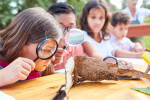As a college science professor, employing effective teaching practices is crucial to engage and support your students’ science learning. Incorporating the teaching practices below into your classroom can help you create a dynamic and engaging learning environment that fosters students’ understanding, enthusiasm, and success in science.
Engage students with science phenomena.
Phenomena are observable events that can be investigated to gather data and evidence to support explanations. Choose phenomena that are engaging and interesting; are observable through video, demonstrations, or simulations; and that have been experienced by students. Encourage students to identify phenomena in their everyday lives, ask their own questions, and make observations. In addition, ask students to identify additional, analogous phenomena that may have similar causes.
Encourage students to ask questions and participate in discussions.
Create an open and welcoming environment for students to ask questions and engage in discussions. Answering queries and promoting dialogue helps clarify misunderstandings and deepens students’ understanding of the subject matter. Promote a learning environment where all students feel comfortable to participate and contribute their ideas and understandings.

Engage students in constructing explanations for why phenomena occur.
Provide students with tools and experiences that allow them to build conceptual understanding of core ideas and encourage them to gather data and evidence that support their explanations for the causes of phenomena. Encourage students to ask questions, gather information from a variety of sources, construct evidence-based investigations, then communicate the reasoning in writing or through presentations or poster sessions.
Shift the focus of labs from following protocols to investigating questions students have about phenomena.
Instead of having your students complete confirmatory labs, design your labs to focus on questions related to the phenomena you are studying. Encourage the class to generate questions, then guide them toward choosing a question that can be investigated using materials in your lab. This provides a powerful context and reason for conducting the lab.
Support students in developing and using scientific models.
Allow students to gather data and obtain information to identify the components of a system and the relationships between components. Use class and small group discussions to develop models and allow opportunities for students to use their models to make and test predictions.
Use formative assessments and constructive feedback.
Use formative assessment techniques such as class discussions, short assignments, and in-class quizzes and polls to gauge students’ comprehension during the learning process. Provide timely and constructive feedback on students’ assignments and performances. Specific feedback helps students understand their strengths and areas for improvement.
Make real-world connections through case studies and problems.
Integrate case studies and real-world problems into your teaching. Case studies allow students to apply their knowledge to analyze complex situations and develop problem-solving skills. Designing solutions to everyday problems provides students with opportunities to use science to solve problems for society.
Foster inclusivity.
Create an inclusive and diverse classroom environment where all students feel valued and respected. Encourage participation from all students and consider different perspectives in your teaching materials and discussions.
Be flexible and willing to adapt your teaching methods for all types of learners.
Incorporate multimedia elements such as visual aids, videos, and interactive simulations to enhance the learning experience. Different students have various learning styles, and multimedia can cater to diverse preferences. Use technology to enhance your teaching, such as online resources, virtual labs, and digital collaboration tools. However, ensure that technology complements the learning process rather than becoming a distraction.
Engage in professional learning.
Stay updated with the latest advancements in your field and in pedagogy. Participate in workshop and conferences, and collaborate with colleagues to continually improve your teaching skills. Organize time with colleagues to discuss and share effective teaching practices.
References
Moulding, Brett D., Bybee, Rodger W. (2017). Teaching Science is Phenomenal: Using Phenomena to Engage Students in Three-Dimensional Science Performances Consistent with NRC Framework and NGSS. Washington, UT: ELM Tree Publishing.
Windschitle, Mark, Thompson, Jessica, Braaten, Melissa. (2018). Ambitious Science Teaching. Cambridge, MA: Harvard Education Press.
McKeachie, Wilbert, Svinicki, Marilla (2010). McKeachie’s Teaching Tips: Strategies, Research, and Theory for College and University Teachers. Wadsworth Engage Learning.
For additional science education information, visit Carolina Knowledge Center—Teaching and Learning.
Math Resources

Modeling Alpha and Beta Decay
A CAROLINA ESSENTIALS INVESTIGATION Total Time Prep: 15 mins Activity: 45 mins Physical Science Grade Level 9-12 High School Quick Links Close Quick Links Open

Bright-Line Spectroscopy and Atomic Structure
A CAROLINA ESSENTIALS INVESTIGATION Total Time Prep: 15 mins Activity: 45-60 mins Physical Science Grade Level 9-12 High School Quick Links Close Quick Links Open

A New Approach to Teaching Atomic Theory
For chemistry teacher Siobhan Julian, teaching the history of atomic theory by lecture “was dry and tedious and boring for everyone involved.†Then she took a fresh approach—one that focuses on doing science to learn science history.
About The Author
Carolina Staff
Carolina is teamed with teachers and continually provides valuable resources–articles, activities, and how-to videos–to help teachers in their classroom.



